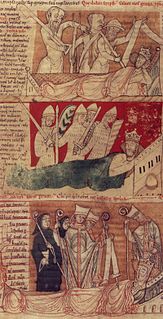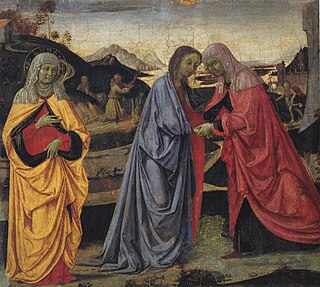
Dante Alighieri, probably baptized Durante di Alighiero degli Alighieri and often referred to simply as Dante, was an Italian poet, writer and philosopher. His Divine Comedy, originally called Comedìa and later christened Divina by Giovanni Boccaccio, is widely considered one of the most important poems of the Middle Ages and the greatest literary work in the Italian language.

Florence is a city in Central Italy and the capital city of the Tuscany region. It is the most populated city in Tuscany, with 383,084 inhabitants in 2013, and over 1,520,000 in its metropolitan area.

Lorenzo di Piero de' Medici was an Italian statesman, banker, de facto ruler of the Florentine Republic and the most powerful and enthusiastic patron of Renaissance culture in Italy. Also known as Lorenzo the Magnificent by contemporary Florentines, he was a magnate, diplomat, politician and patron of scholars, artists, and poets. As a patron, he is best known for his sponsorship of artists such as Botticelli and Michelangelo. He held the balance of power within the Italic League, an alliance of states that stabilized political conditions on the Italian peninsula for decades, and his life coincided with the mature phase of the Italian Renaissance and the Golden Age of Florence. On the foreign policy front, Lorenzo manifested a clear plan to stem the territorial ambitions of Pope Sixtus IV, in the name of the balance of the Italian League of 1454. For these reasons, Lorenzo was the subject of the Pazzi conspiracy (1478), in which his brother Giuliano was assassinated. The Peace of Lodi of 1454 that he supported among the various Italian states collapsed with his death. He is buried in the Medici Chapel in Florence.

Marsilio Ficino was an Italian scholar and Catholic priest who was one of the most influential humanist philosophers of the early Italian Renaissance. He was an astrologer, a reviver of Neoplatonism in touch with the major academics of his day, and the first translator of Plato's complete extant works into Latin. His Florentine Academy, an attempt to revive Plato's Academy, influenced the direction and tenor of the Italian Renaissance and the development of European philosophy.

David is a masterpiece of Renaissance sculpture, created in marble between 1501 and 1504 by the Italian artist Michelangelo. David is a 5.17-metre marble statue of the Biblical figure David, a favoured subject in the art of Florence.

The House of Medici was an Italian banking family and political dynasty that first began to gather prominence under Cosimo de' Medici, in the Republic of Florence during the first half of the 15th century. The family originated in the Mugello region of Tuscany, and prospered gradually until it was able to fund the Medici Bank. This bank was the largest in Europe during the 15th century, and it facilitated the Medicis' rise to political power in Florence, although they officially remained citizens rather than monarchs until the 16th century.

Girolamo Savonarola or Jerome Savonarola was an Italian Dominican friar from Ferrara and preacher active in Renaissance Florence. He was known for his prophecies of civic glory, the destruction of secular art and culture, and his calls for Christian renewal. He denounced clerical corruption, despotic rule, and the exploitation of the poor.

Donato di Niccolò di Betto Bardi, better known as Donatello, was a Florentine sculptor of the Renaissance period. Born in Florence, he studied classical sculpture and used this to develop a complete Renaissance style in sculpture. He spent time in other cities, and while there he worked on commissions and taught others; his periods in Rome, Padua, and Siena introduced to other parts of Italy his techniques, developed in the course of a long and productive career. Financed by Cosimo de' Medici, Donatello's David was the first freestanding nude male sculpture since antiquity.
Florence of Worcester, known in Latin as Florentius, was a monk of Worcester, who played some part in the production of the Chronicon ex chronicis, a Latin world chronicle which begins with the creation and ends in 1140.

The Republic of Florence, officially the Florentine Republic, was a medieval and early modern state that was centered on the Italian city of Florence in Tuscany. The republic originated in 1115, when the Florentine people rebelled against the Margraviate of Tuscany upon the death of Matilda of Tuscany, who controlled vast territories that included Florence. The Florentines formed a commune in her successors' place. The republic was ruled by a council known as the Signoria of Florence. The signoria was chosen by the gonfaloniere, who was elected every two months by Florentine guild members.

Ridolfo di Domenico Bigordi, better known as Ridolfo Ghirlandaio was an Italian Renaissance painter active mainly in Florence. He was the son of Domenico Ghirlandaio.

John of Worcester was an English monk and chronicler who worked at Worcester Priory. He is usually held to be the author of the Chronicon ex chronicis.

Giuseppe Bezzuoli was an Italian painter of the Neoclassic period, active in Milan, Rome, and his native city of Florence.

The ceremonies and festivities accompanying a formal entry by a ruler or his representative into a city in the Middle Ages and Early Modern Period in Europe were known as the Royal Entry, Triumphal Entry, or Joyous Entry. The entry centred on a procession carrying the entering prince into the city, where he was greeted and paid appropriate homage by the civic authorities, followed by a feast and other celebrations.
Stefano Braschi is a retired Italian football referee. He is fluent in Italian, English and French.

The Triumphal Entry of Henry IV into Paris is a 1627 oil on canvas by the artist Peter Paul Rubens, measuring 367 by 693 cm. It shows Henry IV of France's entry into Paris in 1594. It forms a pair with Henry IV at the Battle of Ivry - both were bought by Cosimo III de' Medici in 1686. They are both now in the Uffizi Gallery in Florence, where they have been since 1773.

Lamentation over the Dead Christ is a c. 1500 tempera on panel painting by Giovanni Bellini kept at the Uffizi Gallery in Florence.

Crucifixion is a painting of the Crucifixion of Christ, usually attributed to Perugino, with or without assistance from Luca Signorelli. The work's dating and attribution are both uncertain - Venturi and Schmarsow attribute it to a pupil of Perugino, whilst other art historians attribute it to Perugino alone or with assistance from Signorelli. The deep chiaroscuro is comparable to Signorelli's style elsewhere or to the early style of Perugino whilst he was still heavily influenced by Verrochio. The landscape background is typical of Perugino, with mountains and hills in deep perspective.

Nativity of the Virgin is a small painting in tempera on panel by Pietro Perugino, dating to around 1472 and now in the Walker Art Gallery in Liverpool. It shows the nativity of Mary. The style of the house is heavily influenced by Andrea del Verrocchio.

Visitation is a tempera on panel painting usually attributed to Perugino, executed c. 1472–1473, now in the Galleria dell'Accademia in Florence. An early work by the artist from around the same time as Nativity of the Virgin, whilst he was still heavily influenced by Andrea del Verrocchio, it probably originated as part of the predella for a lost altarpiece. It shows the Visitation, with the Virgin Mary's mother Saint Anne to the left. In the left background is Francis of Assisi receiving the stigmata and in the right background is Florence's patron saint John the Baptist - this may indicate that the lost altarpiece was intended for a Franciscan monastery in Florence such as Santa Croce.


















